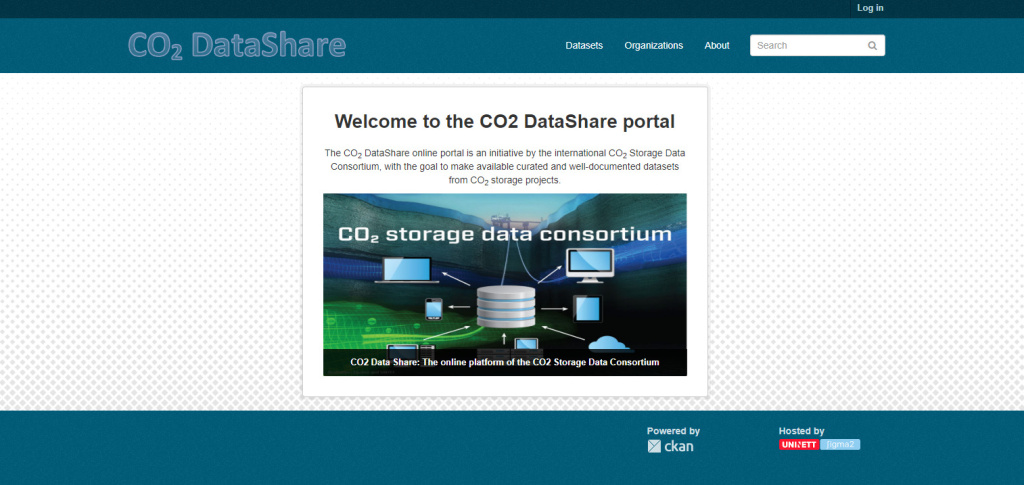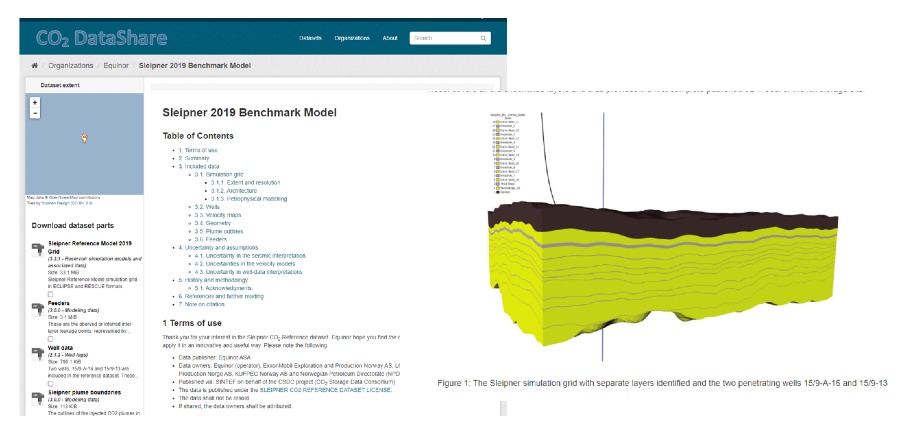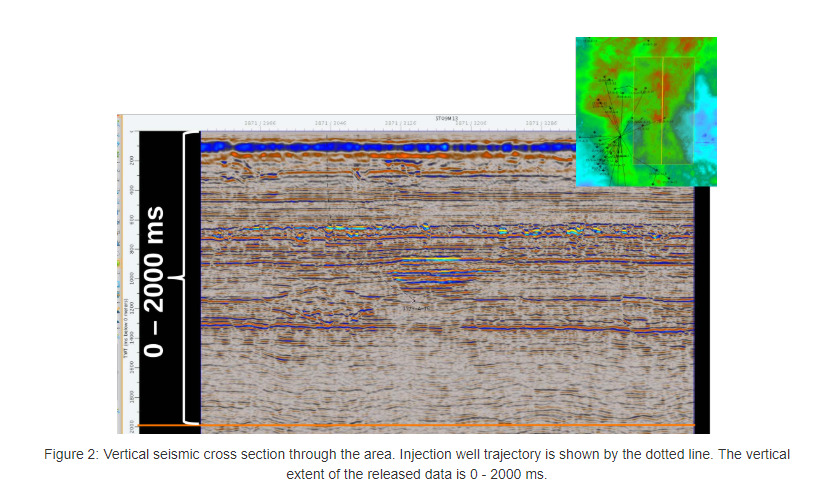
CO2 DataShare is a digital laboratory aimed at accelerating deployment of CCS by allowing researchers to use the best available data to advance knowledge and build capacity.
Authors: Grethe Tangen, SINTEF Industry, Odd Andersen, SINTEF Digital, Philip Ringrose, Equinor.
The new project being developed by the CO2 Storage Data consortium shares reference datasets from ongoing and emerging CCS projects and will continue to advance the functionality of the CO2DataShare digital portal. The main goal is to promote international sharing of reference data from CO2 storage sites in order to fast-track the development of CCS technology around the world.
Sharing quality data to accelerate value creation
CO2DataShare offers a simple, standard, and low-cost solution for making CO2 storage data available, free of charge, to the international research community. Data quality and relevance to CCS research and development are the main criteria for sharing.

Data sharing is important, as access to well-documented, high-quality data promotes the ideals of open, reproducible science and it stimulates accelerated value creation from technology development to deployment of CCS. By facilitating sharing of data that is curated, documented and made comparable, CO2DataShare can serve as an engine for digitalization and digital learning. It also strengthens training and education, especially in countries with limited CCS experience.
Read more: About CO2DataShare and the CO2 Storage Data Consortium
Sharing unique insights from long-term CO2 storage projects
In February 2020, datasets from the pioneer CO2 storage project Sleipner was published on the CO2 DataShare digital portal. Sleipner is the longest ongoing project on CO2 storage in the world. Each year up to 1 million tonnes CO2 from the natural gas is captured and stored at Sleipner. This has provided unique insight into what happens with CO2 stored in the underground over longer periods of time.
The recently published datasets include the 2019 Sleipner reference model and several seismic surveys. The new geological benchmark model for the Sleipner CO2 storage site is built by Equinor based on seismic data calibrated to wells. The simulation grid can be exported to any reservoir simulation package and is useful for investigating dynamic flow within the Sleipner system to understand how CO2 moves in the subsurface.

The released seismic datasets cover the main part of the Sleipner plume as well as the injection well and exploration well, with vertical extent down to 2000 meters. This includes 6 repeated seismic surveys, comprising several time-lapse processing vintages and a high-frequency processing dataset from the 2010 survey. The seismic data represents learnings from many years of CO2 storage monitoring at Sleipner and gives insights into plume growth as a function of time. The seismic data are valuable for understanding the CO2 plume development and containment, for developing enhanced monitoring strategies, and for optimising monitoring programmes for future CCS projects.

There is plenty of evidence to show that the new Sleipner datasets are already in active use. During the first 3 months the Sleipner reference model was downloaded 134 times and one of the seismic vintages was downloaded 85 times. Also, the Norwegian funding agency CLIMIT announced a call inviting researchers to participate in a benchmark study during 2020 on CO2 plume dynamics using the new Sleipner datasets.
In addition to promoting research within universities and research institutes the available datasets are valuable for industrial CCS projects in development as well as for vendors of products and services relevant for CCS deployment.
The CO2 Storage Data consortium is actively pursuing new datasets to include in the portal. We are especially interested in diverse types of datasets, such as early-phase exploration and prospect evaluation data and other types of monitoring data. We hope to have at least one new dataset in place by end of 2020.
The technical solution – co2datashare.org
The CO2Datashare digital portal available at co2datashare.org is currently sharing two reference datasets. The portal is based on the open source software CKAN and hosted by UNINETT Sigma2. The contents, referred to as “reference datasets”, are high-quality datasets that are useful for the larger community, well-documented and with clearly defined usage rights (user license). They are shared by one owning organisation or an organisation with the rights to share on behalf of owning parties. Reference datasets may be open, restricted or under embargo but in general, datasets should be published under an open license.
The front page of the portal is designed for handling a large number of datasets with various options for searching, e.g. using free text, different filters, and a geographical search. Each dataset is structured and documented in a collaborative process between CO2 Datashare and data owner. It has its own, customized web presentation, called the landing page. The landing page serves as the gateway to the datasets and provide both an overview and detailed description of the dataset contents. It may include text, pictures, diagrams, tables and references to selected publications. Online visualization of parts of the included data may also be relevant.
One dataset can consist of one or more data components. During preparation, each data component must be checked for errors and omissions. Data formats and appropriate structuring must be decided according to guidelines and applicable metadata. There is a wide range of relevant data types, such as processed seismic data, well logs, geological models, simulation grids, results from computer simulations, injection histories, surface deformation data, and environmental monitoring data. For each dataset general metadata is structured according to the Dublin Core Metadata initiative while datatype specific metadata will evolve with the increasing number of datasets.
All datasets are assigned a digital object identifier (DOI) that can be used for reference and it links directly back to the dataset’s landing page at the portal. Information on DOI, data ownership and terms of use is easily available at the landing page. As soon as the users have accepted the user terms for a dataset, the selected dataset components can be directly downloaded from the portal.
A presentation of the portal and the datasets currently available in this webinar:
Value to stakeholders
CO2 DataShare brings value to three main groups of stakeholders.
First, for the data owners CO2 DataShare facilitates and supports the data preparation and sharing, saving them time and cost. When international researchers use the data and publish their findings new insights are provided and visibility within CCS is gained both through the presentations of results and academic citations.
Second, for the data users CO2 DataShare enables easy discovery and open access to quality data, it ensures documentation for correct use of the datasets and provides a common ground for international collaboration.
Finally, for society at large CO2 DataShare enables sharing of data from industry projects as well as publicly funded research. Access to data can also boost the research and development within CO2 storage required to accelerate CCS deployment and by participating as members of the project board the national funding agencies can guide the strategic direction.
The Digital Lab: Bringing CO2 DataShare to the next level
The CO2 Storage Data Consortium is now developing a continuation project (Phase 2) that will enable further sharing of reference datasets from ongoing and emerging CCS projects with further enhancements of the functionality of the CO2 DataShare portal. In particular, we want to promote the value of this digital platform for enabling innovation and discovery in the fields of CCS. Specific goals of the Phase 2 project are to:
- Promote international sharing of reference data from CO2 storage sites:
- Expand the base of datasets in the CO2 DataShare digital portal
- Ensure long term (>5 years) operation and maintenance of the infrastructure
- Advance the CO2 DataShare digital portal to cover the whole CCS chain
- Further development of support for online collaboration, visualization, and API functionality
- Build a network of international stakeholders, data owners, data users and
public agencies:- Facilitate dialogue and collaboration between owners and users of data
- Organize webinars and meetings to discuss datasets and share results
from research using the datasets
- Support spin-off research and innovation projects (national and international):
- Using available datasets (e.g. AI, Machine Learning, modelling)
- Generating new datasets, complementing the knowledge base
The consortium is actively seeking additional countries to join and support. CCS projects interested in sharing datasets along with decision makers in the energy transition are welcome to contact us for more information about the project and how to participate.
The CO2 Storage Data Consortium is an open international network for data and knowledge exchange, initiated by Equinor, SINTEF, University of Illinois and IEAGHG in 2016. CO2 DataShare Phase 1 (2017-2021) receives financial support from Gassnova and US Department of Energy. The project is coordinated with the Norwegian CCS Research Centre, NCCS.
Authors: Grethe Tangen, SINTEF Industry, Odd Andersen, SINTEF Digital, Philip Ringrose, Equinor.

0 comments on “Sharing CO2 Storage Data to Fast-Track CCS Development”